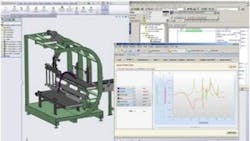Machine builders know that the old saying "time is money" has never been truer than it is today. Getting a machine to market faster ultimately translates into an improved bottom line. As a result, machine builders often look to the design phase of machine development to save valuable time.
In addition, a variety of external pressures also lead machine builders to be mindful of simplifying their design processes. Today's end-users are demanding machines that run with greater efficiency, more quickly adapt to market changes and integrate with up and downstream operations. Global competition and tight regulations, meanwhile, put pressure on manufacturers to be more responsive and transparent.
To help meet these new challenges, machine builders can turn to three time-saving methods: a mechatronic design approach, the EtherNet/IP network and Accelerators.
Optimizing the Design Approach Using Mechatronics
Rockwell Automation defines mechatronics as a multi-disciplinary design approach relying on the collaborative application of motion design software and products. When mechanical, electrical and control engineers work in parallel to design a machine, they are able to more quickly create an optimized machine.
Using a mechatronic approach, engineers are able to reduce design time through virtual prototyping. These digital simulations help engineers to quickly determine an optimized solution by finding errors early in the design process. Further, engineers can input design information in a familiar environment and understand how their design decisions affect the system as a whole, allowing them to quickly evaluate design alternatives and select the best one.
Industry trends are making it easier for a company of any size to benefit from a mechatronic design approach. Computer processing power that makes virtual prototyping possible continues to improve and become more affordable. Mechatronic design software has become easier to use through improved work flow and graphical user interfaces. New functionality has provided even more optimization and analysis options.
Simplifying the Network with EtherNet/IP
Industrial Ethernet is another method machine builders are using to cut design time. Previously, multi-tiered network strategies were a necessity, as each application, from motion to safety, required its own dedicated network. By replacing this multi-tier networking strategy with one standard network architecture, machine builders can reduce their engineering time, integration risks and Total Cost to Design, Develop and DeliverSM machines.
EtherNet/IP™ is the only established industrial protocol that is designed to connect from the instrumentation level all the way up to the end customer's IT infrastructure, and across applications, including discrete, process, safety, motion and drive control. EtherNet/IP is built on standard TCP/IP technology and is the world's leading industrial Ethernet network. Integrated Motion on EtherNet/IP provides the speed and precision to meet demanding motion applications.
Other motion networks focus on building a network with extreme speed, then sending through extremely large amounts of traffic and relying on the network be fast enough to get all information through in time. EtherNet/IP uses time synchronization, a more efficient way to get the performance and precision that motion control demands. Time reference is distributed across nodes so the network does not have to be scheduled. Network traffic is dramatically reduced because the size and content of data packages can be dynamically changed.
EtherNet/IP gives machine builders a simplified network solution that can connect their motion application to the rest of their machine through one single channel, to other machines, to the entire line and even up into the business level. This streamlines the design phase because machine builders don't need to consider separate network requirements and specifications when designing the motion application.
Beyond design, EtherNet/IP offers the security and network segmentation that meets the needs of machine builders and end users. It also allows machine builders the opportunity to easily add secure remote services that can differentiate them from their competitors.
Focus on What's Important With Accelerators
A series of Accelerators have been developed to reduce design time. For motion applications, the recently released Drives and Motors Accelerator Toolkit (DMAT) from Rockwell Automation can help users reduce the time and cost of developing a new application using Rockwell Automation equipment, especially PowerFlex® AC Drives and Kinetix® servo drives.
The easy-to-use tools and templates assist customers with a wide variety of design tasks, from selecting components and developing drawings, to writing application code, laying out HMI screens, starting up their machine -- and troubleshooting. This complete suite of design tools is available on one free DVD.
The idea behind the DMAT is to help users quickly take care of the mundane, often time-consuming -- but necessary -- core tasks involved in the machine building process by providing easy to use modules which provide a solid foundation of functionality and features. This frees up machine builders to focus on designing unique features and differentiating their machine.
The DMAT uses a modular format that greatly simplifies the work needed when building applications with multiple product lines. In practice, customers have reported design time savings of up to 50 percent by using the DMAT's simplified programming/configuration modular structure, checklists and step-by-step instructions. For more information and sample downloads, go to: www.ab.com/go/iatools
Bringing it All Together
Mechatronics, EtherNet/IP and Accelerators such as DMAT can be used collectively to minimize design time and maximize resource utilization. Each provides a different but effective method for helping machine builders reduce the amount of time devoted to designing and building a machine.
A mechatronics approach during the design process helps machine builders ensure their machine is efficient and cost effective. EtherNet/IP can provide machine builders with the flexibility and performance required for demanding applications all on a single network architecture. Finally, Accelerators provide a programming backbone to get machines up and running faster. Every machine builder has an eye on reducing design time; these are three ways to get started.
Total Cost to Design, Develop and Deliver, PowerFlex and Kinetix are trademarks of Rockwell Automation, Inc. EtherNet/IP is a trademark of ODVA.
Sponsored Links